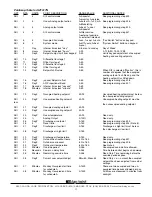
3. Press the PROGRAM SETUP button until you reach the
screen # 14 which allows you to set the occupant set-
point adjustment limits. Change this to +/-20 °F (11.1
°C). Press the PROGRAM SETUP button once more to
store the change. Then press the SERVICE STATUS but-
ton once to exit the programming.
4. Press the FAN SWITCH button to access the fan mode
and change the mode to AUTO. Press the FAN SWITCH
button once more to store the change. Press the SYS-
TEM SWITCH button to access the system mode and
change the mode to AUTO. Press the SYSTEM
SWITCH button once more to store the change.
5. Verify that the thermostat is operating in the occupied
mode by making sure that the top LED is lit. If not, press
the OVERRIDE button. The LED should light up.
6. Take note of the current temperature reading. Press the
WARMER (up) button. The setpoint adjustment screen
should now be showing. Press the WARMER button
until the heating setpoint is greater than the current tem-
perature by at least five degrees. The fan will come on.
The heating stage(s) will sequence on after 30 seconds.
7. Press the cooler (down) button until the heating setpoint
is one degree less than the current temperature. The heat-
ing stage(s) will sequence off. The fan will turn off 30
seconds after the last heating stage.
8. Press the cooler button until the cooling setpoint is less
than the current temperature by at least five degrees. The
fan will come on. The cooling stage(s) will sequence on
after 30 seconds.
9. Press the warmer button until the cooling setpoint is
greater than the current temperature by one degree. The
cooling stage(s) will sequence off. The fan will turn off
30 seconds after the last cooling stage.
10. Take note of the room (and discharge) air temperatures.
If the analog output is set for Cooling, press the Cooler
button until the cooling setpoint is less than the current
room temperature by at least 5°. The cooling device
should start operating. If the analog output is set for
Heating, press the Warmer button until the heating set-
point is greater than the current room temperature by at
least 5°. The heating device should start operating.
11. Go back to programming step #14 and set the setpoint
adjust limit back to the desired value. Make any other
changes in programming, clock, and schedule. Set the
fan and system modes to their desired settings.
12. If using remote sensors, verify that the reading is cor-
rect. If not, see
Wrong Temperature Display
in
“Troubleshooting” section.
TROUBLESHOOTING
No Display
Check for 24 VAC on terminals “+24” and “-24”. Check the
cable connecting the cover to the base for a good connec-
tion.
Fan Does Not Come On
The fan is on whenever the fan LED is on. If the fan should
be on, but the fan LED is off, check the fan and system switch
modes, and the unoccupied fan mode in programming. If the
fan is off but the fan LED is on, check wiring. Short terminals
“R” to “G” and see if the fan comes on. This is a check for a
mechanical relay failure.
Heating or Cooling Does Not Come On
At least one stage of heating is on whenever the heating LED
is on, and at least one stage of cooling is on whenever the
cooling LED is on. If heating or cooling should be on but the
heating or cooling LED is off, check the fan and system
switch modes. Also, check the heating and cooling setpoints,
offsets and differentials, and the room temperature to be sure
heating or cooling should be on. If using outdoor air heating
and cooling lockouts, or discharge air high and low limits,
check their values to be sure heating or cooling is allowed. If
heating or cooling is off, but the corresponding LED is on,
check the wiring. Short terminals “R” to “Y/W1” or “Y/W2”
and see if the heating or cooling comes on. This is a check for
a mechanical relay failure.
Wrong Temperature Display
If any of the temperatures is reading slightly high or low, there
are three adjustment pots located in the cover to adjust them.
“T1” is for the room temperature, “T2” is for the discharge air
temperature, and “T3” is for the outdoor air temperature. If the
temperature is at a minimum or maximum reading, check the
sensor dipswitch positions. (See setup instructions.) Check for
wiring problems (opens or shorts). A remote 1000
Ω
sensor
should read 1080 to 1090
Ω
at room temperature. The built-in
sensor should read 108 to 109
Ω
at room temperature.
Service LED is On
If the service LED is on, it may be for monitoring purposes or
it may indicate a critical problem. The first monitoring screen
accessed by pressing the service status button will display why
the light is on.
Outputs Will Not Shut Off
First check the room temperature and the setpoints and deter-
mine whether the output should be on. There are delays and
minimum on and off times for the fan and heating and cooling
stages. Also, check the service status menus to verify that the
outputs are on. Turning the system to “off” will instantly turn
all outputs off. The thermostat can be reset by pressing the
system switch button and the service status button simultane-
ously.
R
2800 LAURA LANE
I
MIDDLETON, WI 53562
I
(800) 288-9383
I
FAX (608) 836-9044
I
www.tcs-basys.com
10
















